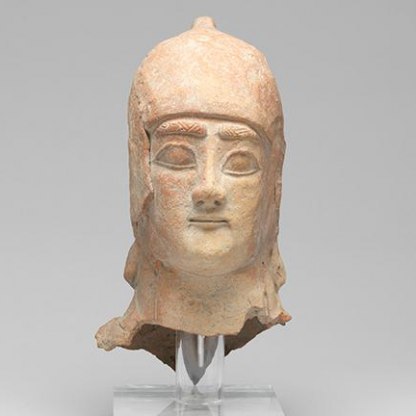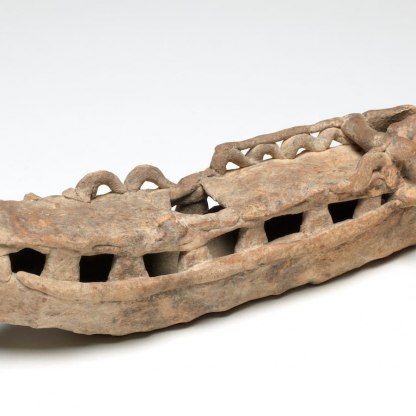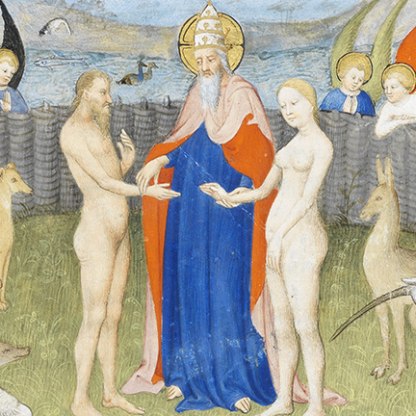Being an Islander: Art and Identity of the Large Mediterranean Islands
‘Being an Islander: Art and Identity of the large Mediterranean Islands' runs as a research project between 2019 and 2023, with a major exhibition opening on 21 February 2023 and closing on 4 June 2023. Both the exhibition and research project, together with corresponding outreach activities, aim to elucidate what defined island identities in the Mediterranean. They explore how insularity affected and shaped cultural identity using the examples of Crete, Cyprus, and Sardinia, and provide a platform to debate cultural evolution in the islands as opposed to the surrounding mainland. The exhibition will extend beyond the topic of the Ancient Mediterranean, incorporating the current perceptions of and discourses about island versus mainland cultural identities (e.g. including Britain’s own, debated island identity).
Research background
Throughout history, islands have been treated as distinct places, unlike mainland and continental masses. In geographic terms, islands are merely pieces of land surrounded by water, but the perception of island life has never been neutral. Rather, the term ‘insularity’ – belonging to/being of an island – has been romanticised and associated with otherness. Islands have often been deemed to have different histories from the mainland and with more readily isolated socio-political, cultural, and economic characteristics.Yet, connectivity has also been an important feature of island life as the sea can be a linking rather than just a dividing body, motivating and maintaining informal and formal connections. This has been made evident by the flourishing studies of the archaeology, art, and history of the Mediterranean islands.
‘Being an Islander: Art and Identity of the large Mediterranean Islands' has a broad diachronic scope and applies integrative analytical approach. Our exhibits will integrate research findings from scientific fields within archaeology, such as ceramics studies, archaeobotany, and archaeometallurgy, as well as its multi-scalar approaches to past human interaction within continental and island environments. They will also engage works of modern artists whose creations contemplate what belonging to an island means. The exhibition and research mostly confront the perception that ‘being an islander’ is a distinctive attribute or a set of well-defined characteristics. Instead, we argue, ‘being an islander’ is a highly fluid state of being, whether consciously or not, both in the past and the present. Through key artefacts and interactive installations the exhibition makes a case for thinking of the Mediterranean regions surrounding this dynamic body of water in terms of connectivity and mobility rather than through the entrenched disciplinary divides and modern political boundaries.
Redefining insular identity
The large Mediterranean islands have often been given a special status due to their size, biodiversity, and cultural elaboration, but at no point in antiquity were they coherent social or cultural entities with fixed borders. Even though symbolic boundaries can be maintained more easily when coinciding with firm physical boundaries of land and sea, there is much diversity within them, with social, cultural, economic, and political networks stretching beyond their limits. Likewise, the social and cultural identities of their inhabitants were multiple, ever-changing, and continually negotiated.
This project explores island identities and how islanders of Crete, Cyprus, and Sardinia interacted with inhabitants of other islands and the mainland (ancient Greece, the Levant, Anatolia, and Italy); how they produced and integrated material culture from their neighbours as an expression of their own identities; and, most importantly, the way they fashioned and shaped their distinct social and cultural identities as islanders. We explore these parameters through specific case-studies using objects from Crete, Cyprus, and Sardinia, and the understating that the degree of the islanders’ openness as well as the intensity of their connections fluctuated over time depending on historical circumstances and social agency.
Understanding mobility
Our secondary aim is to reframe mobility as one of the defining characteristics of the ancient Mediterranean insular societies. While the intensity of this phenomenon may have varied through time and space and not all members of a particular community or island may have shared equally in it, mobility – and the connectivity it engendered – endowed the region with its particular characteristics. Contributors to the research project – in the form of research collaborations, chapters in an edited volume, and papers that will be delivered at a conference accompanying the opening of the exhibition, in addition to other outputs – debate and expand on the notions of mobility and connectivity. With specific temporal and geographical case studies from the three islands, they all demonstrate that both mobility and connectivity are important features of island life, motivating and maintaining informal and formal connections. The case studies additionally elucidate the interplay between mobility, connectivity, and resilience, all aspects of insular life that waxed and waned throughout history.
Project information
- Principal Investigator: Anastasia Christophilopoulou
- Project start date: 1 January 2019
- Project end date: 31 December 2023
Related publications
Major outputs
Books
- Christophilopoulou, A. editor. Being an Islander: Art and Identity of the Large Mediterranean Islands 2500BC- 31 BC (forthcoming, 2023). The Fitzwilliam Museum, Cambridge.
This edited volume is one of three major outputs of the research and exhibition project by the Fitzwilliam Museum. The volume disseminates the research results of the project and includes chapters from prominent scholars responding to the three main themes of the exhibition (insularity, mobility, and diachronicity); it also incorporates a complete catalogue of the 160 objects on display as part of the exhibition. The edited volume has two parts: part 1 with 13 innovative essays, bringing together recently developed examination of insularity within the Mediterranean context of the three large islands: Cyprus, Crete, and Sardinia; and part 2 with a concise catalogue of the exhibition’s objects. Part 1 interprets island cultures diachronically and across archaeology and the related disciplines, including those coming from the field of archaeological sciences, and contributes to the way we understand these islands today (e.g., through osteoarchaeology, archaeometallurgy, analysis of ceramics). It also draws on the field of Ancient History as well as meditations on insularity through modern art.
Conferences and workshops organised
- Christophilopoulou, A. 2020. “Imagining islands, meditating on mainlands”, Workshop at the Archaeological Institute of America Annual Meeting, Washington DC, 5 January 5, 2020. Speakers: Prof. N. Mac Sweeney, Dr J. Mokrišová, Dr E. Margaritis, Prof. Marian Feldman, Prof. Louise Hitchcock, Dr Jeffery Emanuel
Invited talks and conference papers
- Christophilopoulou, A. and G. Artopoulos. 2020. “Immersing in Virtual Island-scapes: A case study in museum virtual environments, reconstruction: methods and practices in research, exhibitions, and conservation”, Centre for Visual Culture Inaugural Conference, Trinity Hall, Cambridge, February 24-25, 2020.
- Christophilopoulou, A. 2020. “The project: “Being an Islander: Art and Identity of the Large Mediterranean Islands”, Le grandi isole del Meditterraneo: rotte E legami tra bronzo e ferro, Tourisma 2020, Firenze, Palazzo dei Congressi February 22-23, 2020.
- Christophilopoulou, A. “Being an Islander: Art and Identity of the Large Mediterranean Islands, or, Can museums really contribute to research in social sciences?” Wolfson College Humanities Society Lecture, January 28, 2020.
- Christophilopoulou, A. 2019. “Investigating ancient Cypriot food practices and diets as part of the narratives developed for the ‘Being an Islander’: Art and Identity of the Large Mediterranean Islands’ exhibition”, in Cypriot Archaeology, Pre-Modern Material Culture, and Cultural Heritage in the UK, International Conference, Institute of Archaeology University College London, April 2019.
- Christophilopoulou, A. 2017. “Cyprus in Context: researching and re-assessing the Cambridge Cypriot Collections”, Annual Lawrence Room Lecture, Girton College, Cambridge, September 23, 2017.
- Christophilopoulou, A. 2017. “Cyprus in Context: The Bronze Age material in the Cyprus collection of the Fitzwilliam Museum”, Science & Technology in Archaeology Research Center Symposium, The Cyprus Institute, Nicosia, April 6, 2017.
- Christophilopoulou, A. 2016. “The Cyprus in Context project”, Objects, Collections, Curation. A Symposium in honour of Dr. Lucilla Burn, King’s College, Cambridge, November 29, 2016.
- Christophilopoulou, A. 2015. “A ‘quest’ for Salamis within the collection of Cypriot Antiquities of the Fitzwilliam Museum, Cambridge”, Salamis 2015 International Conference, University of Cyprus, Nicosia, May 21–23, 2015.
Related work
- Kotsonas, A. and J. Mokrišová. “Mobility, Migration, and Colonization.” In A Companion to the Archaeology of Early Greece and the Mediterranean, edited by I. Lemos and A. Kotsonas, 217-246. Blackwell Companions to the Ancient World. Hoboken, NJ: Wiley-Blackwell.
- Christophilopoulou, A. 2016. ‘Re-examining the history of Cypriot antiquities in the Fitzwilliam Museum: a closer look at the collection’s past and future’, in G. Bourogiannis and C. Muhlenbock eds., Ancient Cyprus Today: Museum Collections and New Research(SIMA pocket-book 184), Uppsala, 13–19.
- Christophilopoulou, A. “Re-approaching Cyprus: A Day Devoted to Recent Research in Cypriot Archaeology and Cypriot Collections”, International conference at the Fitzwilliam Museum, Cambridge, 23 October 2015.
- Christophilopoulou, A. 2013. ‘Does the Cretan house stand alone? Households in Geometric Crete viewed in the context of domestic architecture in the Cyclades and the eastern Aegean’, in W.D. Niemeier, O.Pilz und I. Kaiser eds., Kreta in der geometrischen und archaischen Zeit. Akten des internationalen Kolloquiums am Deutschen Archäologischen Institut (Athenaia 2), München, 437–453.
- Christophilopoulou, A. 2010. “Review of Karageorghis V. and Giannikouri A. eds., Conservation and presentation of the cultural and natural heritage of the large islands of the Mediterranean”, Proceedings of the International Symposium, Rhodes 2006. The Classical Review 60: 266–268.
- Christophilopoulou, A. 2010. ‘Domestic space and community identity in the Aegean islands and Crete’, MOSAIK Journal, Raumdimensionen im Altertum, Berlin.
- Christophilopoulou, A. 2007. ‘Domestic space in the Geometric Cyclades: A study of spatial arrangements, function and household activities in Zagora on Andros, and Kastro on Siphnos’, in E. Hallager and J. Jensen eds., The Proceedings of the Danish Institute at Athens V, Athens.
Project team
Other participants
- Susanna Pancaldo (Conservator of Objects, Fitzwilliam Museum)
- Dr Ema Baužytė (Research Associate for scientific analysis of archaeological metals, Fitzwilliam Museum)
- Dr Laura Dierksmeier, (Universitat Tubingen, PI, DFG Research Network, 'Insular Dynamics').
- Daniel Pett (Head of Digital, Fitzwilliam Museum)
- Dr David Evans ( Exhibitions Manager, Fitzwilliam Museum)
- Professor Marcos Martinon-Torres (Pitt-Rivers Professor of Archaeological Science, McDonald Institute for Archaeological Research, Cambridge)
- Dr Despina Pilides (Curator of Antiquities, Department of Antiquities, Nicosia, Cyprus)
- Dr Marina Solomidou-Ieronymidou (Director, Department of Antiquities, Nicosia, Cyprus)
- Dr Polyxeni Adam-Veleni, (Director General of Antiquities and Cultural Heritage, Greece).
- Dr Evi Margaritis (Assistant Professor, The Cyprus Institute, Nicosia)
- Dr Giorgos Artopoulos (Assistant Professor, The Cyprus Institute, Nicosia)
- Yorgos Petrou, (Contemporary Artist, London)
- Dr Dimitrios Bouras (Social Anthropologist, Documentarist)
- Mr Orestis Seferoglou ( Documentary Photographer).
- Professor Naoíse Mac Sweeney (Professor of Classical Archaeology, Institute for Classical Archaeology, Vienna)
- Dr Michael Loy (British School at Athens)
- Dr Achilleas Hadjikyriacou (Royal Holloway, University of London)
- Rafael Laoutari (PhD Candidate, Department of Archaeology and Fitzwilliam Museum, Cambridge)
Outcomes of the project
Public engagement actions, events, and training programmes
Since 2019, the project has implemented over 15 public engagement actions, workshops, talks, and seminars nationally and internationally, in addition to object-handling sessions in the Fitzwilliam Museum. Major public engagement outputs are expected as we approach the year of the exhibition.
A selection of our recent actions includes:
- Handling sessions for general and research audiences in the Fitzwilliam Museum with material from the Cypriot and Aegean Collections
- Touch tours of the Cypriot and Aegean World Antiquities of the Fitzwilliam Museum for blind and partially sighted audiences, as well as groups of people with other physical or mental disabilities and their carers
- Nora at The Fitz: a literary evening with award-winning Cypriot author Nora Nadjarian, introduced by Ingrid Jendrzejewski and narrated by the curators, researchers, and staff of the Fitzwilliam Museum. This event took place under the auspices of HE the High Commissioner of Cyprus in the UK, Mr Andreas S. Kakouris at the A. G. Leventis Gallery of Ancient Cyprus, Fitzwilliam Museum, January 30, 2020 (60 participants)
- A series of workshops (entitled Make Your Own Boat), narrations, and activities on the theme of ancient migration around the Mediterranean, organised by the Learning Team and researchers of the Fitzwilliam Museum for the Cambridge Festival of Ideas, October 22, 2019 (40 participants)
- Object pottery and metalware handling session by the project’s curator and conservators for the Alumni Festival on September 27, 2019 (40 participants)
- Professor Paul Cartledge and Dr Anastasia Christophilopoulou narrated the history of the city of Salamis, Cyprus and of the antiquities from the region now housed in the Fitzwilliam Museum
Other research projects you might like
Sign up to our emails
Be the first to hear about our news, exhibitions, events and more…


